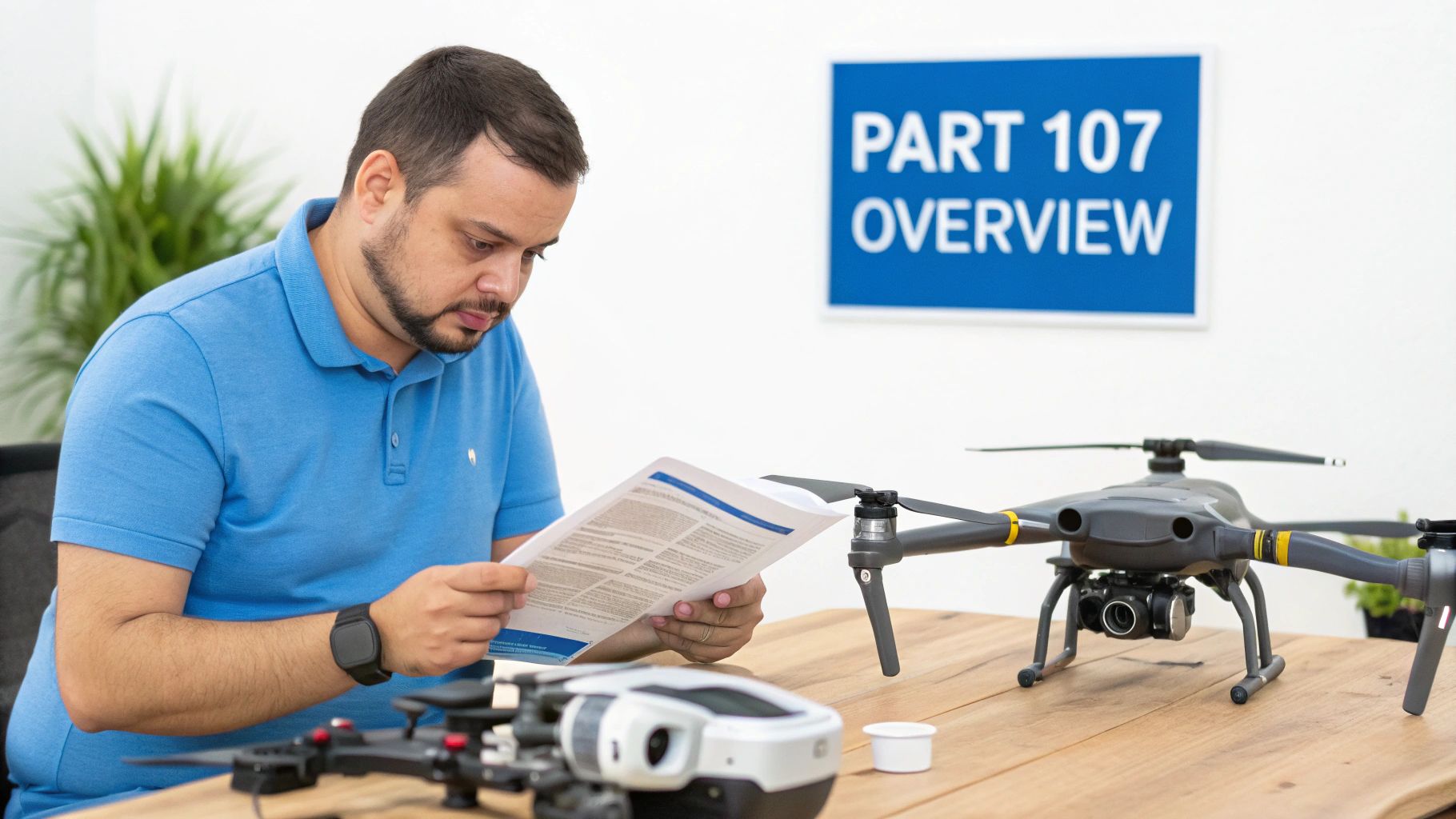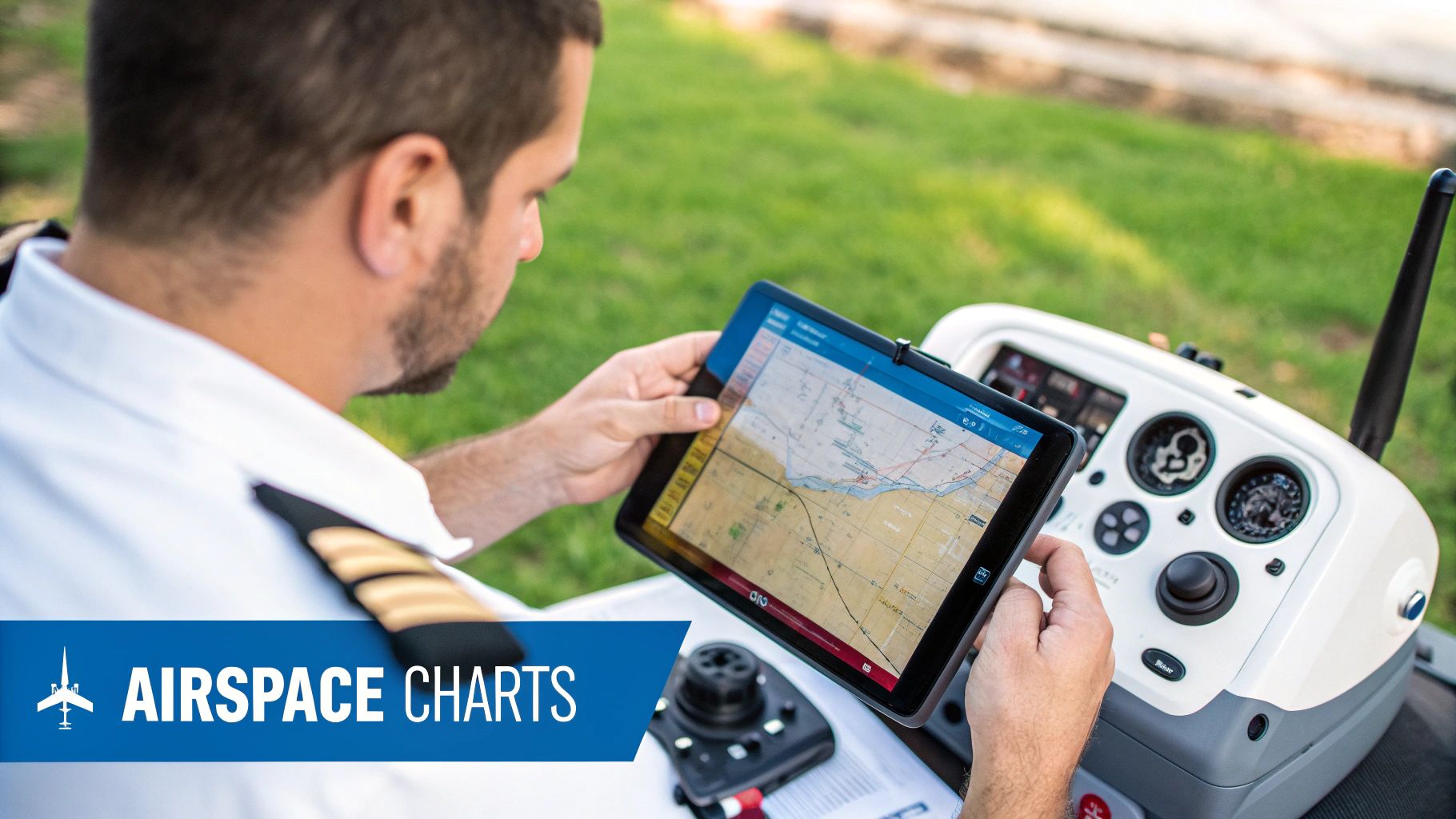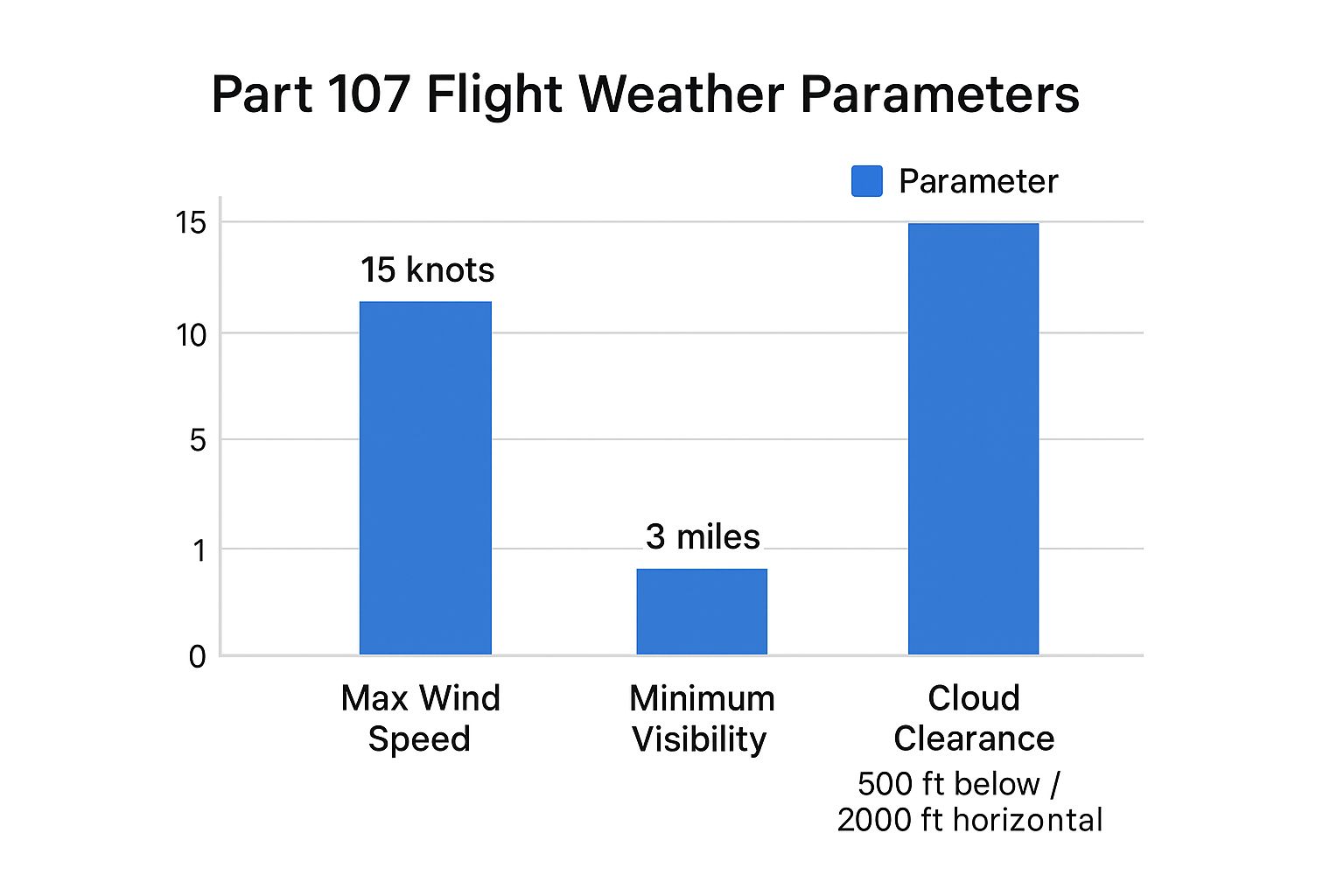Part 107 Study Guide: Ace Your FAA Drone Exam
- Paul Simmons

- May 12
- 11 min read
Updated: May 13
Breaking Down Part 107: What Every Drone Pilot Must Know

So, you're dreaming of taking your drone skills to the next level and flying commercially? That means getting familiar with Part 107, the essential regulation for professional drone operations in the United States. It's more than just a certificate; it's your ticket to legally and safely operating a drone for business. Understanding Part 107 sets you up for success, both on the exam and in building a solid drone career. For extra help preparing for the exam, check out this Part 107 Study Guide.
Why Part 107 Matters
Officially known as the Small Unmanned Aircraft Rule, Part 107 was established by the FAA in 2016. It provides the guidelines for commercial drone operation in the US. The rule requires drone pilots to obtain a Remote Pilot Certificate, proving their knowledge and commitment to safety. This certification has been vital to the growth and professionalism of the commercial drone industry.
What Does Part 107 Certification Entail?
Getting your Part 107 certificate comes down to passing a knowledge test. This exam covers key areas essential for safe drone operation: airspace regulations, weather interpretation, flight procedures, and emergency protocols. Mastering this information isn’t just about passing the test; it’s about becoming a responsible and safe drone pilot.
Key Areas of Focus for Your Part 107 Study Guide
A solid Part 107 study guide focuses on several important topics. Understanding airspace classifications (from Class A to G) is crucial. Knowing the difference between controlled and uncontrolled airspace, for instance, determines where and how you can fly.
Weather is another vital element in drone operations. You'll need to interpret weather reports and understand how different conditions affect flight safety. Check out our drone blog posts for more info.
Your study plan should also cover flight operations, including pre-flight checks, emergency procedures, and proper communication protocols. Finally, understanding the legal and regulatory aspects of Part 107 is key. This means knowing your responsibilities as a remote pilot, including incident reporting and record-keeping. Using effective study tips can also significantly improve your preparation.
The following table summarizes the key requirements and restrictions of Part 107:
Part 107 Certification at a Glance: Summary of key Part 107 requirements and restrictions
Requirement | Details | Restrictions |
|---|---|---|
Remote Pilot Certificate | Must pass knowledge test administered by the FAA | |
Airspace Knowledge | Understand airspace classifications (A-G) and regulations | Restrictions on operating in certain airspaces (e.g., Class B, C, D, and E) without prior authorization |
Weather Proficiency | Interpret weather reports and understand impacts on flight safety | No flying in unsafe weather conditions (e.g., strong winds, heavy rain, fog) |
Flight Operations | Knowledge of pre-flight checks, emergency procedures, and communication | Maximum altitude of 400 feet above ground level (AGL), or within 400 feet of a structure |
Legal & Regulatory Compliance | Understand responsibilities regarding incident reporting and record-keeping | Operations must be within visual line of sight (VLOS) |
This table provides a quick overview of the critical areas covered under Part 107. A comprehensive understanding of these elements is essential for safe and legal drone operations.
Mastering Airspace Knowledge That Examiners Love to Test
Airspace regulations are a critical component of the Part 107 exam. This section simplifies the complexities of airspace classifications (Class A through G), using real-world examples to illustrate how regulatory knowledge applies to practical flying scenarios. A solid understanding of airspace is essential for safe and legal drone operations.
Decoding Sectional Charts
Sectional charts are essential tools for drone pilots, serving as your roadmap in the sky. They provide a comprehensive overview of airspace classifications, restrictions, and other crucial information. Learning to interpret these charts effectively, including identifying airspace boundaries, altitudes, and potential hazards, is vital for both the exam and your daily drone flights.
Airspace Classifications: A Simplified Overview
Each airspace classification, from the restricted airspace around major airports (Class B) to the uncontrolled airspace often found in rural areas (Class G), has its own set of rules. Think of Class A airspace as the "highway in the sky," reserved for large aircraft, while Class G is more like a local road with fewer restrictions. Mastering these distinctions is key to passing your exam.
Navigating Temporary Flight Restrictions (TFRs)
Temporary Flight Restrictions (TFRs) are temporary restrictions on airspace due to events like wildfires, major sporting events, or presidential movements. Consider them temporary road closures in the sky. Checking for TFRs before each flight is crucial to avoid penalties and ensure safety. Online resources and tools can help you stay updated on current TFRs. You might be interested in: Our event page.
Practical Authorization Procedures
Operating in controlled airspace often requires authorization. While this process can be complex, it's manageable with the right knowledge. Understanding the required steps, documentation, and communication procedures with air traffic control will prepare you to fly legally and confidently in these areas. The implementation of Part 107 has significantly increased commercial drone operations. By 2020, thousands of operators had obtained certification due to the streamlined process for acquiring a Remote Pilot Certificate. Find more detailed statistics here.
Altitude Restrictions: Knowing Your Limits
Altitude restrictions vary depending on airspace classification and nearby obstacles. Visualize these restrictions as vertical boundaries in the sky. Understanding these limits, often expressed in feet above ground level (AGL) or above mean sea level (MSL), is essential for safe and compliant flight planning. This knowledge is a significant part of the Part 107 exam. Remember, mastering these concepts is crucial not only for passing the exam but also for building a successful career as a remote pilot.
Weather Factors: The Hidden Key to Exam Success
Weather plays a crucial role in drone operations. Understanding its impact is not just about safety, it's a key part of the Part 107 exam. This section covers the essential weather concepts you'll need to know to interpret aviation reports and understand how weather affects drone performance.
Decoding METARs and TAFs
METARs (Meteorological Aerodrome Reports) give you current weather observations. Think of them as a snapshot of what's happening right now. TAFs (Terminal Aerodrome Forecasts), on the other hand, predict future conditions, like a short-term weather preview. Knowing how to read these reports, including wind speed, visibility, and cloud cover, is vital for making informed decisions about whether or not to fly.
Weather Phenomena and Drone Performance
Certain weather events can significantly impact drone flights. Microbursts, sudden downdrafts of air, can cause rapid altitude loss and even damage your drone. Temperature inversions, where warmer air sits above cooler air, can also affect drone performance by trapping pollutants and creating unstable air.
This can lead to unexpected turbulence. Frontal systems, the boundaries between different air masses, bring rapid weather changes, including strong winds, precipitation, and changes in visibility. Being aware of these phenomena is crucial for safe drone operations.
Density Altitude: A Critical Calculation
Density altitude refers to the altitude relative to standard atmospheric conditions. It’s a critical concept for drone pilots because it directly impacts how your drone performs. A higher density altitude means the air is thinner, reducing lift and requiring more power to maintain altitude.
For instance, flying on a hot day at a lower altitude can actually mean a higher density altitude. Understanding and calculating density altitude is essential for both safe flights and the Part 107 exam.
Cloud Clearance and Visibility Minimums
The Part 107 exam stresses the importance of cloud clearance and visibility minimums. You must maintain 500 feet below clouds and 2,000 feet horizontally from them. Visibility must be at least 3 statute miles. Knowing and adhering to these minimums is crucial for safe and legal drone flights. You might find our blog categories page helpful for further reading.
Pre-Flight Weather Resources
Before every flight, consult reliable weather resources. Websites and apps dedicated to aviation weather provide up-to-the-minute METARs, TAFs, and other critical weather data. A pre-flight weather checklist is an indispensable tool for every drone pilot. By mastering these weather concepts and using the right resources, you'll be prepared for the Part 107 exam and set for safe and successful drone operations.
Flight Operations: Turning Test Knowledge Into Airborne Safety

Passing the Part 107 knowledge test is a major accomplishment. But the true learning experience begins when you put that knowledge into action during actual flight operations. This section helps bridge the gap between theoretical knowledge and practical application, providing valuable insights from experienced remote pilots to get you ready for safe and successful drone flights.
Pre-Flight Inspections: Your First Line of Defense
Before every flight, a comprehensive pre-flight inspection is essential. This isn't simply a suggestion; it's a crucial safety measure that safeguards your equipment and ensures you comply with Part 107 regulations. Consider it like checking the vital signs of your drone. Every drone pilot should incorporate a detailed checklist, covering everything from battery health to propeller condition, into their pre-flight routine.
Some key pre-flight checks include:
Battery Check: Confirm the battery's charge and look for any signs of damage or swelling.
Propeller Inspection: Make sure the propellers are firmly attached and free of any cracks or damage.
Sensor Calibration: Calibrate the drone's GPS and IMU (Inertial Measurement Unit) to ensure accurate flight data.
Firmware Updates: Verify your drone is running the most recent firmware version.
Control Link Test: Establish a solid connection between your drone and the controller before taking off.
These checks might seem small, but they can prevent serious issues in the air.
Emergency Procedures: Staying Calm Under Pressure
A responsible drone pilot knows how to handle emergencies effectively. The Part 107 exam covers emergency procedures, and this section builds upon those concepts with real-world scenarios. Understanding lost-link protocols, for example, is critical. What happens if your drone loses connection with the controller? A pre-programmed return-to-home function can be a lifesaver.
Knowing how to respond to mid-flight system failures is equally important. Imagine a motor malfunctioning during a crucial maneuver. Your reaction will determine the outcome. Regularly practicing emergency procedures builds muscle memory, enabling you to react swiftly and effectively under pressure. This preparation can prevent a minor problem from escalating into a major accident.
Weight and Balance, Payload Management, and Battery Safety
Weight and balance directly impact flight stability. Think of your drone as a small aircraft. Just like larger aircraft, its center of gravity influences its handling. Overloading your drone or distributing weight improperly can result in unstable flight and potential crashes.
Payload management is particularly important for commercial drone operations. Securely attaching cameras, sensors, or other equipment is essential for data accuracy and preventing in-flight incidents. Effective payload management ensures mission success.
Battery safety involves more than just checking the charge level. LiPo batteries, commonly used in drones, require cautious handling and storage. Overcharging or puncturing a LiPo battery can cause a fire. Following appropriate battery safety protocols extends battery life and minimizes risks.
Crew Resource Management and Effective Communication
Even solo drone pilots benefit from crew resource management (CRM) principles. CRM emphasizes situational awareness, clear communication, and informed decision-making. Communicating effectively with stakeholders—clients, landowners, or even bystanders—is key for seamless operations and maintaining a professional image.
Developing sound decision-making skills is what distinguishes casual drone operators from true professionals. This includes understanding your limitations, knowing when to postpone a flight due to weather conditions, and always putting safety first. These skills, while crucial for real-world flying, also reinforce the knowledge assessed in the Part 107 exam. This well-rounded approach, combining practical skills with exam preparation, prepares you to become a successful and responsible remote pilot.
Cracking the Test: Insider Strategies From Recent Test-Takers
Passing the Part 107 exam isn't just about studying; it's about understanding the test itself. This section, drawing on insights from recent test-takers, offers strategies, question format insights, and targeted approaches for the toughest topics.
Understanding the Exam Structure
The Part 107 exam has 60 multiple-choice questions. You get two hours to finish, needing 70% or higher to pass. Knowing this helps you manage your time – roughly two minutes per question.
Decoding Challenging Question Categories
Recent test-takers consistently highlight a few tricky areas. Airspace regulations, especially reading sectional charts and understanding Temporary Flight Restrictions (TFRs), often require careful thought. Weather questions, particularly those on METARs and TAFs, are another challenge. Finally, regulations on flight operations, including emergency procedures and pre-flight checks, need close attention.
Sample Questions and Explanations
Practice questions offer great insight into the exam format. For example: Under what conditions can a drone pilot operate in Class B airspace? The correct answer involves getting prior authorization from air traffic control. This highlights the need to know airspace rules.
Specialized Study Techniques for Part 107
Focus your studies on the key Part 107 knowledge areas. For airspace, practice decoding sectional charts and visualizing airspace classifications. For weather, regularly interpret METARs and TAFs. For operations, use checklists and rehearse emergency procedures. Read also: Our sitemap page for related resources.
Test-Taking Strategies for Success
Even if you're unsure, good test-taking strategies can help. Rule out obviously wrong answers. If you're stuck between two choices, go with your gut. Don’t overthink – simple questions often have simple answers.
Managing Test Anxiety and Maintaining Focus
Test anxiety can affect performance. Use techniques to stay calm and focused. Deep breathing before and during the exam helps reduce stress. Visualize yourself confidently finishing the test. A clear mind will improve recall.
Visualizing Key Weather Parameters

This infographic shows the key weather limits for Part 107 drone operations: maximum wind speed, minimum visibility, and required cloud clearance. You need 500 feet below and 2,000 feet horizontally from clouds, at least 3 miles of visibility, and winds below 15 knots. Knowing these is crucial for safe, compliant flights.
To help you further prepare, let's look at the key topics covered in the exam:
Part 107 Exam Topic Breakdown: Distribution of question topics on the Part 107 knowledge test
Knowledge Area | Approximate Percentage | Key Concepts |
|---|---|---|
Regulations | 40% | Part 107 rules, airspace classifications, operating requirements |
Meteorology | 20% | Weather interpretation, METARs, TAFs |
Aeronautics | 20% | Flight principles, aircraft performance, radio communication |
Airspace | 15% | Sectional charts, airspace restrictions, TFRs |
Operations | 5% | Emergency procedures, pre-flight inspections, crew resource management |
This table highlights the relative importance of each area, allowing you to prioritize your study efforts. Regulations and Meteorology combined make up a significant portion of the exam.
By using these strategies, your Part 107 study guide becomes your roadmap to exam success and prepares you to be a certified remote pilot.
Beyond the Certificate: Your Path as a Professional Remote Pilot

Passing the Part 107 knowledge test and receiving your Remote Pilot Certificate is a major accomplishment. But it's not the destination; it's the starting point. This section explores the next steps in your professional journey as a certified remote pilot, using insights from seasoned drone operators. Want to boost your exam prep? Incorporating general study tips can make a real difference.
Certificate Issuance and Display
After successfully completing the exam, you'll receive a temporary certificate. The official Part 107 certificate will arrive a few weeks later. Properly displaying your credentials is essential for compliance. Just like a driver's license, your drone certificate should be readily accessible during operations.
The 24-Month Renewal Process: Staying Current
Your Part 107 certificate is valid for 24 months. Renewal requires passing a recurrent knowledge test. This process ensures you're current with the latest regulations and safety protocols. Many experienced pilots use online resources and practice exams between testing cycles. This helps maintain operational safety and prepares them for the recurrent test.
Legal Responsibilities and Record-Keeping
Certified remote pilots have important legal responsibilities. Understanding and following incident reporting procedures, even for minor incidents, is crucial. Accurate flight logs and records are also essential. These records are vital documentation in case of any issues and help you track flight hours and operational information. It's similar to a detailed vehicle maintenance log – valuable protection for you and your business.
Navigating the Waiver Process
Standard Part 107 rules have operational limitations, such as nighttime flight and operations over people. If your work requires exceeding these limitations, you can apply for a waiver from the FAA. A successful waiver application requires a detailed and convincing safety case. This means outlining your planned operation, explaining your safety measures, and demonstrating how you'll mitigate potential risks. A thorough approach significantly increases your chances of approval.
Building Your Professional Network
Connecting with other drone professionals is invaluable. Join industry associations and participate in online forums. Networking provides opportunities to learn, stay updated on industry trends, and even discover job opportunities. It's also a great way to find mentors and collaborators, boosting your professional growth.
Earning your Part 107 certificate opens doors to a growing industry. Staying informed, adhering to regulations, and constantly developing your skills will set you up for success as a professional remote pilot. Ready for more? Visit JAB Drone for expert insights, product reviews, and everything you need to excel in the world of unmanned aerial vehicles.




Comments